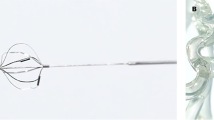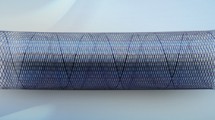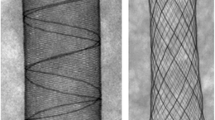Abstract
Purpose
It has been hypothesized that microstents which are used to prevent coil protrusion in the treatment of cerebral aneurysms may have flow diverting and therefore occlusive effects. In a rabbit elastase aneurysm model, we investigated the aneurysm occlusion rate and vessel reaction of a braided Accero stent prototype with porosity in the lower range of other available (non-flow-diverter) microstents.
Methods
Ten aneurysms were induced the right subclavian artery in New Zealand white rabbits and treated with the Accero stent prototype. In each subject, a second stent was implanted in the abdominal aorta to cover the origins of branch arteries. Angiographic follow-up and explantation of the devices and aneurysms for histological analysis were performed after 3 months (n = 5) and 6 months (n = 5).
Results
Grades I (< 50%) and II (> 50%) occlusion rates were observed in 9 (90%) and 1 (10%) of ten aneurysms treated with the stent device. The mean reduction in contrast filling at 6 months was 42.1% (p = .02). Neointima thickness was significantly higher in the subclavian artery than in the abdominal aorta after 3 (p = .03), whereas not after 6 months (p = .1). No cases of inadequate wall apposition, branch artery occlusion or stent thrombosis were observed.
Conclusion
The present study showed flow remodelling properties of the device prototype with progredient aneurysm occlusion. A larger in vivo study with induced aneurysm should be done to confirm these results.




Similar content being viewed by others
References
Lieber BB, Stancampiano AP, Wakhloo AK. Alteration of hemodynamics in aneurysm models by stenting: influence of stent porosity. Ann Biomed Eng. 1997;25(3):460–9.
Han PP, Albuquerque FC, Ponce FA, MacKay CI, Zabramski JM, Spetzler RF, et al. Percutaneous intracranial stent placement for aneurysms. J Neurosurg. 2003;99(1):23–30. https://doi.org/10.3171/jns.2003.99.1.0023.
Wang C, Tian Z, Liu J, Jing L, Paliwal N, Wang S, et al. Flow diverter effect of LVIS stent on cerebral aneurysm hemodynamics: a comparison with enterprise stents and the pipeline device. J Transl Med. 2016;14(1):199. https://doi.org/10.1186/s12967-016-0959-9.
Aydin K, Barburoglu M, Sencer S, Berdikhojayev M, Coskun B, Akpek S. Flow diversion with low-profile braided stents for the treatment of very small or uncoilable intracranial aneurysms at or distal to the circle of Willis. AJNR Am J Neuroradiol. 2017;38(11):2131–7. https://doi.org/10.3174/ajnr.A5362.
Cagnazzo F, Cappucci M, Dargazanli C, Lefevre PH, Gascou G, Riquelme C, et al. Flow-diversion effect of LEO stents: aneurysm occlusion and flow remodeling of covered side branches and perforators. AJNR Am J Neuroradiol. 2018;39(11):2057–63. https://doi.org/10.3174/ajnr.A5803.
Pumar JM, Lete I, Pardo MI, Vazquez-Herrero F, Blanco M. LEO stent monotherapy for the endovascular reconstruction of fusiform aneurysms of the middle cerebral artery. AJNR Am J Neuroradiol. 2008;29(9):1775–6. https://doi.org/10.3174/ajnr.A1155.
Lanzino G, Wakhloo AK, Fessler RD, Hartney ML, Guterman LR, Hopkins LN. Efficacy and current limitations of intravascular stents for intracranial internal carotid, vertebral, and basilar artery aneurysms. J Neurosurg. 1999;91(4):538–46. https://doi.org/10.3171/jns.1999.91.4.0538.
Kallmes DF, Ding YH, Dai D, Kadirvel R, Lewis DA, Cloft HJ. A new endoluminal, flow-disrupting device for treatment of saccular aneurysms. Stroke J Cereb Circ. 2007;38(8):2346–52. https://doi.org/10.1161/STROKEAHA.106.479576.
Ahlhelm F, Roth C, Kaufmann R, Schulte-Altedorneburg G, Romeike BF, Reith W. Treatment of wide-necked intracranial aneurysms with a novel self-expanding two-zonal endovascular stent device. Neuroradiology. 2007;49(12):1023–8. https://doi.org/10.1007/s00234-007-0281-6.
Kulcsar Z, Houdart E, Bonafe A, Parker G, Millar J, Goddard AJ, et al. Intra-aneurysmal thrombosis as a possible cause of delayed aneurysm rupture after flow-diversion treatment. AJNR Am J Neuroradiol. 2011;32(1):20–5. https://doi.org/10.3174/ajnr.A2370.
Yavuz K, Geyik S, Saatci I, Cekirge HS. Endovascular treatment of middle cerebral artery aneurysms with flow modification with the use of the pipeline embolization device. AJNR Am J Neuroradiol. 2014;35(3):529–35. https://doi.org/10.3174/ajnr.A3692.
Brinjikji W, Lanzino G, Cloft HJ, Siddiqui AH, Boccardi E, Cekirge S, et al. risk factors for ischemic complications following pipeline embolization device treatment of intracranial aneurysms: results from the IntrePED study. AJNR Am J Neuroradiol. 2016;37(9):1673–8. https://doi.org/10.3174/ajnr.A4807.
Pumar JM, Banguero A, Cuellar H, Guimaraens L, Masso J, Miralbes S, et al. treatment of intracranial aneurysms with the SILK embolization device in a multicenter study. Retrosp Data Anal Neurosurg. 2017. https://doi.org/10.1093/neuros/nyw123.
Altes TA, Cloft HJ, Short JG, DeGast A, Do HM, Helm GA, et al. 1999 ARRS Executive Council Award. Creation of saccular aneurysms in the rabbit: a model suitable for testing endovascular devices. American Roentgen Ray Society. AJR Am J Roentgenol. 2000;174(2):349–54. https://doi.org/10.2214/ajr.174.2.1740349.
Fujiwara NH, Cloft HJ, Marx WF, Short JG, Jensen ME, Kallmes DF. Serial angiography in an elastase-induced aneurysm model in rabbits: evidence for progressive aneurysm enlargement after creation. AJNR Am J Neuroradiol. 2001;22(4):698–703.
Kamran M, Yarnold J, Grunwald IQ, Byrne JV. Assessment of angiographic outcomes after flow diversion treatment of intracranial aneurysms: a new grading schema. Neuroradiology. 2011;53(7):501–8. https://doi.org/10.1007/s00234-010-0767-5.
Safain MG, Roguski M, Heller RS, Malek AM. Flow diverter therapy with the pipeline embolization device is associated with an elevated rate of delayed fluid-attenuated inversion recovery lesions. Stroke J Cereb Circ. 2016;47(3):789–97. https://doi.org/10.1161/STROKEAHA.115.010522.
Zhou G, Su M, Yin YL, Li MH. Complications associated with the use of flow-diverting devices for cerebral aneurysms: a systematic review and meta-analysis. Neurosurg Focus. 2017;42(6):E17. https://doi.org/10.3171/2017.3.FOCUS16450.
Matsuda Y, Chung J, Keigher K, Lopes D. A comparison between the new low-profile visualized intraluminal support (LVIS Blue) stent and the flow redirection endoluminal device (FRED) in bench-top and cadaver studies. J Neurointerv Surg. 2017. https://doi.org/10.1136/neurintsurg-2017-013074.
Mohlenbruch MA, Kizilkilic O, Killer-Oberpfalzer M, Baltacioglu F, Islak C, Bendszus M, et al. multicenter experience with FRED Jr flow re-direction endoluminal device for intracranial aneurysms in small arteries. AJNR Am J Neuroradiol. 2017;38(10):1959–65. https://doi.org/10.3174/ajnr.A5332.
Xu D, Zhang C, Wang T, Wang C, Kallmes DF, Lanzino G, et al. Evaluation of enterprise stent-assisted coiling and telescoping stent technique as treatment of supraclinoid blister aneurysms of the internal carotid artery. World Neurosurg. 2018;110:e890–6. https://doi.org/10.1016/j.wneu.2017.11.119.
Bouillot P, Brina O, Ouared R, Lovblad KO, Farhat M, Pereira VM. Particle imaging velocimetry evaluation of intracranial stents in sidewall aneurysm: hemodynamic transition related to the stent design. PLoS one. 2014;9(12):e113762. https://doi.org/10.1371/journal.pone.0113762.
Suzuki T, Takao H, Fujimura S, Dahmani C, Ishibashi T, Mamori H, et al. Selection of helical braided flow diverter stents based on hemodynamic performance and mechanical properties. J Neurointerv Surg. 2017;9(10):999–1005. https://doi.org/10.1136/neurintsurg-2016-012561.
Kim YJ, Ko JH. Sole stenting with large cell stents for very small ruptured intracranial aneurysms. Interv Neuroradiol J Perither Neuroradiol Surg Proced Relat Neurosci. 2014;20(1):45–53. https://doi.org/10.15274/INR-2014-10007.
Kallmes DF, Ding YH, Dai D, Kadirvel R, Lewis DA, Cloft HJ. A second-generation, endoluminal, flow-disrupting device for treatment of saccular aneurysms. AJNR Am J Neuroradiol. 2009;30(6):1153–8. https://doi.org/10.3174/ajnr.A1530.
Sadasivan C, Cesar L, Seong J, Rakian A, Hao Q, Tio FO, et al. An original flow diversion device for the treatment of intracranial aneurysms: evaluation in the rabbit elastase-induced model. Stroke J Cereb Circ. 2009;40(3):952–8. https://doi.org/10.1161/STROKEAHA.108.533760.
Ley D, Muhl-Benninghaus R, Yilmaz U, Korner H, Cattaneo GF, Mailander W, et al. The Derivo embolization device, a second-generation flow diverter for the treatment of intracranial aneurysms, evaluated in an elastase-induced aneurysm model. Clin Neuroradiol. 2015. https://doi.org/10.1007/s00062-015-0493-9.
Wang K, Huang Q, Hong B, Li Z, Fang X, Liu J. Correlation of aneurysm occlusion with actual metal coverage at neck after implantation of flow-diverting stent in rabbit models. Neuroradiology. 2012;54(6):607–13. https://doi.org/10.1007/s00234-011-0922-7.
Cho SH, Jo WI, Jo YE, Yang KH, Park JC, Lee DH. Bench-top comparison of physical properties of 4 commercially-available self-expanding intracranial stents. Neurointervention. 2017;12(1):31–9. https://doi.org/10.5469/neuroint.2017.12.1.31.
Gester K, Luchtefeld I, Busen M, Sonntag SJ, Linde T, Steinseifer U, et al. In vitro evaluation of intra-aneurysmal, flow-diverter-induced thrombus formation: a feasibility study. AJNR Am J Neuroradiol. 2016;37(3):490–6. https://doi.org/10.3174/ajnr.A4555.
Dai D, Ding YH, Kadirvel R, Rad AE, Lewis DA, Kallmes DF. Patency of branches after coverage with multiple telescoping flow-diverter devices: an in vivo study in rabbits. AJNR Am J Neuroradiol. 2012;33(1):171–4. https://doi.org/10.3174/ajnr.A2879.
Simgen A, Ley D, Roth C, Yilmaz U, Korner H, Muhl-Benninghaus R, et al. Evaluation of a newly designed flow diverter for the treatment of intracranial aneurysms in an elastase-induced aneurysm model, in New Zealand white rabbits. Neuroradiology. 2013. https://doi.org/10.1007/s00234-013-1296-9.
Simgen A, Ley D, Roth C, Cattaneo GF, Muhl-Benninghaus R, Muller A, et al. Evaluation of occurring complications after flow diverter treatment of elastase-induced aneurysm in rabbits using micro-CT and MRI at 9.4 T. Neuroradiology. 2016;58(10):987–96. https://doi.org/10.1007/s00234-016-1730-x.
Funding
This work was supported by the German Ministry of Economic Affairs and Energy (Grant No KF2335804AJ2) and partially funded by Acandis GmbH, Pforzheim, Germany.
Author information
Authors and Affiliations
Corresponding author
Ethics declarations
Conflict of interest
Giorgio Cattaneo was engineer at the company Acandis GmbH until August 2019, Andreas Ding is engineer at the company Acandis GmbH (Pforzheim, Germany). Both served as proctors during this study.
Ethical Approval
All applicable international, national and/or institutional guidelines for the care and use of animals were followed. All procedures performed in studies involving animals were in accordance with the ethical standards of the institution or practice at which the studies were conducted. This study obtained approval by the local animal protection committee (No. 44/13).
Additional information
Publisher's Note
Springer Nature remains neutral with regard to jurisdictional claims in published maps and institutional affiliations.
Electronic supplementary material
Below is the link to the electronic supplementary material.
Rights and permissions
About this article
Cite this article
Mühl-Benninghaus, R., Abboud, R., Ding, A. et al. Preclinical Evaluation of the Accero Stent: Flow Remodelling Effect on Aneurysm, Vessel Reaction and Side Branch Patency. Cardiovasc Intervent Radiol 42, 1786–1794 (2019). https://doi.org/10.1007/s00270-019-02345-z
Received:
Accepted:
Published:
Issue Date:
DOI: https://doi.org/10.1007/s00270-019-02345-z




